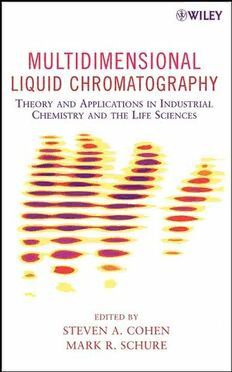
Multidimensional Liquid Chromatography: Theory and Applications in Industrial Chemistry and the Life Sciences PDF
Preview Multidimensional Liquid Chromatography: Theory and Applications in Industrial Chemistry and the Life Sciences
MULTIDIMENSIONAL LIQUID CHROMATOGRAPHY MULTIDIMENSIONAL LIQUID CHROMATOGRAPHY Theory and Applications in Industrial Chemistry and the Life Sciences Edited by STEVENA. COHEN LifeSciencesR&D,WatersCorporation Milford,MA01757,USA MARK R. SCHURE TheoreticalSeparationScienceLaboratory RohmandHaasCompany Springhouse,PA19477-0904,USA A JOHN WILEY & SONS, INC., PUBLICATION Copyright(cid:1)2008byJohnWiley&Sons,Inc.Allrightsreserved. PublishedbyJohnWiley&Sons,Inc.,Hoboken,NewJersey PublishedsimultaneouslyinCanada Nopartofthispublicationmaybereproduced,storedinaretrievalsystem,ortransmittedinanyformor byanymeans,electronic,mechanical,photocopying,recording,scanning,orotherwise,exceptas permittedunderSection107or108ofthe1976UnitedStatesCopyrightAct,withouteithertheprior writtenpermissionofthePublisher,orauthorizationthroughpaymentoftheappropriateper-copyfeeto theCopyrightClearanceCenter,Inc.,222RosewoodDrive,Danvers,MA01923,978-750-8400, fax978-750-4470,oronthewebatwww.copyright.com.RequeststothePublisherforpermissionshould beaddressedtothePermissionsDepartment,JohnWiley&Sons,Inc.,111RiverStreet,Hoboken,NJ 07030,201-748-6011,fax201-748-6008,oronlineathttp://www.wiley.com/go/permission. LimitofLiability/DisclaimerofWarranty:Whilethepublisherandauthorhaveusedtheirbesteffortsin preparingthisbook,theymakenorepresentationsorwarrantieswithrespecttotheaccuracyor completenessofthecontentsofthisbookandspecificallydisclaimanyimpliedwarrantiesof merchantabilityorfitnessforaparticularpurpose.Nowarrantymaybecreatedorextendedbysales representativesorwrittensalesmaterials.Theadviceandstrategiescontainedhereinmaynotbesuitable foryoursituation.Youshouldconsultwithaprofessionalwhereappropriate.Neitherthepublisher norauthorshallbeliableforanylossofprofitoranyothercommercialdamages,includingbutnotlimited tospecial,incidental,consequential,orotherdamages. Forgeneralinformationonourotherproductsandservicesorfortechnicalsupport,pleasecontactour CustomerCareDepartmentwithintheUnitedStatesat800-762-2974,outsidetheUnitedStatesat 317-572-3993orfax317-572-4002. Wileyalsopublishesitsbooksinavarietyofelectronicformats.Somecontentthatappearsinprintmaynot beavailableinelectronicformats.FormoreinformationaboutWileyproducts,visitourwebsiteatwww. wiley.com. LibraryofCongressCataloging-in-PublicationData: Multidimensionalliquidchromatography:theoryandapplicationsinindustrialchemistryandthelife sciences/editedByStevenA.Cohen,MarkR.Schure. p. cm. Includesindex. ISBN978-0-471-73847-3(cloth) 1. Liquidchromatography.2. Chemicalengineering.3. Chemistry,Technical. 4. Biochemistry. I.Cohen,StevenA.,1953-II.Schure,MarkR.;1952- QD79.C454M852007 543’.84–dc22 2007041576 PrintedintheUnitedStatesofAmerica 10987654321 CONTENTS Foreword xiii Preface xv Contributors xvii 1 Introduction 1 1.1 PreviousLiteratureWhichCoversMDLC 4 1.2 HowthisBookisOrganized 5 References 6 PARTI THEORY 9 2 ElementsoftheTheoryofMultidimensional LiquidChromatography 11 2.1 Introduction 11 2.2 PeakCapacity 13 2.3 Resolution 17 2.4 Orthogonality 19 2.5 Two-DimensionalTheoryofPeakOverlap 21 2.6 Dimensionality,PeakOrdering,andClustering 23 2.7 TheoryofZoneSampling 24 2.8 DilutionandLimitofDetection 26 2.9 ChemometricAnalysis 27 v vi CONTENTS 2.10 FutureDirections 28 References 30 3 PeakCapacityinTwo-DimensionalLiquidChromatography 35 3.1 Introduction 35 3.2 Theory 37 3.3 Procedures 41 3.4 ResultsandDiscussion 42 3.5 Conclusions 49 Appendix3AGenerationofRandomCorrelatedCoordinates 50 Appendix3BDerivationofLimitingCorrelationCoefficientr 54 References 56 4 DecodingComplex2DSeparations 59 4.1 Introduction 59 4.2 Fundamentals:TheStatisticalDescriptionofComplex MulticomponentSeparations 62 4.3 Decoding1Dand2DMulticomponentSeparations byUsingtheSMOPoissonStatistics 68 4.4 DecodingMulticomponentSeparationsbythe AutocovarianceFunction 74 4.5 Applicationto2DSeparations 78 4.5.1 ResultsfromSMOMethod 81 4.5.2 Resultsfrom2DAutocovariance FunctionMethod 84 4.6 ConcludingRemarks 88 Acknowledgments 88 References 88 PARTII COLUMNS,INSTRUMENTATIONANDMETHODS DEVELOPMENT 91 5 InstrumentationforComprehensiveMultidimensional LiquidChromatography 93 5.1 Introduction 93 5.2 Heart-CuttingVersusComprehensiveMode 95 5.3 ChromatographicHardware 97 5.3.1 Valves 97 5.4 CEInterfaces 104 5.4.1 GatedInterfaceforHPLC–CE 104 5.4.2 MicrofluidicValvesforOn-Chip MultidimensionalAnalysis 105 CONTENTS vii 5.5 ColumnsandCombinations 106 5.5.1 ColumnSystems,Dilution,andSplitting 108 5.6 Detection 109 5.7 ComputerHardwareandSoftware 109 5.7.1 SoftwareDevelopment 110 5.7.2 ValveSequencing 111 5.7.3 DataFormatandStorage 113 5.8 ZoneVisualization 115 5.8.1 ContourVisualization 115 5.8.2 2DPeakPresentation 117 5.8.3 ZoneVisualizationinSpecificChemical(pI)Regions 117 5.8.4 ExternalPlottingPrograms 117 5.8.5 DifferencePlots 118 5.8.6 Multi-channelData 118 5.9 DataAnalysisandSignalProcessing 119 5.10 FutureProspects 120 References 121 6 MethodDevelopmentinComprehensiveMultidimensional LiquidChromatography 127 6.1 Introduction 127 6.2 PreviousWork 128 6.3 ColumnVariables 130 6.4 MethodDevelopment 130 6.4.1 TheCardinalRulesof2DLCMethodDevelopment 132 6.5 PlanningtheExperiment 143 6.6 GeneralCommentsonOptimizingthe2DLCExperiment: Speed–ResolutionTrade-off 143 Acknowledgment 144 References 144 7 MonolithicColumnsandTheir2D-HPLCApplications 147 7.1 Introduction 147 7.2 MonolithicPolymerColumns 148 7.2.1 StructuralPropertiesofPolymerMonoliths 148 7.2.2 ChromatographicPropertiesof PolymerMonolithicColumns 150 7.2.3 Two-DimensionalHPLCUsingPolymerMonoliths 152 7.3 MonolithicSilicaColumns 153 7.3.1 Preparation 154 7.3.2 StructuralPropertiesofMonolithicSilicaColumns 154 7.3.3 ChromatographicPropertiesof MonolithicSilicaColumns 156 viii CONTENTS 7.4 PeakCapacityIncreasebyUsingMonolithicSilicaColumns inGradientElution 158 7.5 2DHPLCUsingMonolithicSilicaColumns 159 7.5.1 RP-RP2DHPLCUsingTwoDifferentColumns 161 7.5.2 RP–RP2DHPLCUsingTwoSimilarColumns 164 7.5.3 IonExchange–Reversed-Phase2DHPLC UsingaMonolithicColumnforthe2nd-D 166 7.5.4 IEX-RP2DHPLCUsingaMonolithicRP CapillaryColumnforthe2nd-D 168 7.6 SummaryandFutureImprovementof2DHPLC 171 References 171 8 UltrahighPressureMultidimensionalLiquidChromatography 177 8.1 Background:MDLCintheJorgensonLab 177 8.1.1 CationExchange–SizeExclusion 178 8.1.2 AnionExchange–ReversedPhase 180 8.1.3 CationExchange–ReversedPhase 181 8.1.4 SizeExclusion–ReversedPhase 183 8.2 OnlineVersusOff-LineMDLC 188 8.3 MDLCUsingUltrahighPressureLiquidChromatography: BenefitsandChallenges 189 8.3.1 AnIntroductiontoUHPLC 190 8.3.2 UHPLCforLC(cid:1)LC:HighSpeed VersusHighPeakCapacity 191 8.3.3 LC(cid:1)UHPLCforSeparationsofIntactProteins 191 8.4 ExperimentalDetails 193 8.4.1 Instrumentation 193 8.4.2 DataAnalysis 194 8.4.3 ChromatographicConditions 195 8.4.4 Samples 196 8.5 ResultsandDiscussion 196 8.6 FutureDirectionsforUHP-MDLC 202 References 203 PARTIII LIFESCIENCEAPPLICATIONS 205 9 Peptidomics 207 9.1 StateoftheArt—WhyPeptidomics? 207 9.2 StrategiesandSolutions 208 9.3 SummaryandConclusions 218 References 218 CONTENTS ix 10 ATwo-DimensionalLiquidMassMappingTechnique forBiomarkerDiscovery 221 10.1 Introduction 221 10.2 MethodsforSeparatingandIdentifyingProteins 223 10.2.1 pI-BasedMethodsofSeparation 223 10.2.2 Chromatofocusing-AColumnBasedpHSeparation 225 10.2.3 NonporousSeparationofProteins 226 10.2.4 Electrospray-TimeofFlight-MassSpectrometry 228 10.2.5 MALDIPeptideMassFingerprinting 229 10.2.6 DataAnalysisandRecombination 230 10.3 Applications 230 10.3.1 ProteomicMappingandClustering ofMultipleSamples—Applicationto OvarianCancerCellLines 230 10.3.2 2DLiquidMassMappingofTumorCellLine SecretedSamples,Applicationto Metastasis-AssociatedProteinProfiles 233 10.3.3 IdentificationAnnotationandDataCorrelationin MCF10HumanBreastCancerCellLines 235 10.4 SummaryandConclusions 237 Acknowledgments 238 References 238 11 CoupledMultidimensionalChromatographyandTandemMass SpectrometrySystemsforComplexPeptideMixtureAnalysis 243 11.1 SCX-RP/MS/MS 245 11.2 SCX/RP/MS/MS 248 11.3 MudPIT 251 11.4 AlternativeFirstDimensionApproaches 254 11.5 Conclusion 255 References 255 12 DevelopmentofOrthogonal2DLCMethods forSeparationofPeptides 261 12.1 Introduction 261 12.2 PreviousWork 263 12.3 DevelopingOrthogonal2DLCMethods 264 12.3.1 LCSelectivityforPeptides:ExperimentalDesign 264 12.3.2 Investigationof2DLCOrthogonality forSeparationofPeptides 266 12.3.3 GeometricApproachtoOrthogonalityin2DLC 271 12.3.4 Practical2DLCConsiderationsinProteomeResearch 275 12.3.5 EvaluationofSelected2DLCMS/MSSystems 276 x CONTENTS 12.3.6 PeakCapacityin2DLC-MS/MS 280 12.3.7 ConsiderationsofConcentrationDynamicRange 282 12.4 Conclusions 284 Acknowledgment 284 References 284 13 MultidimensionalSeparationofProteinswithOnlineElectrospray Time-of-FlightMassSpectrometricDetection 291 13.1 Introduction 291 13.2 ChromatographicParameters 293 13.3 AnalyteDetectionandSubsequentAnalysis 293 13.4 BuildingaMultidimensionalProteinSeparation 294 13.4.1 SelectionofanIon-Exchange–Reversed-Phase SeparationSystemforProtein-LevelSeparations 295 13.4.2 ChromatographicSorbentConsiderations 295 13.4.3 ChromatographicBehaviorofProteins 296 13.5 ComprehensiveMultidimensionalChromatographicSystems 296 13.6 Coupling2DLCwithOnlineESI–MSDetection 299 13.6.1 InteractionsbetweentheTwoDimensionsof Chromatography(StepVs.Linear) 304 13.6.2 RecognizingIncreasedSelectivityin2DLCSeparations 306 13.7 ExpandingMultidimensionalSeparationsintoa“Middle-Out” ApproachtoProteomicAnalysis 308 13.8 FutureDirectionsinProteinMDLC 311 13.8.1 ProteinChromatography 312 13.8.2 MSAnalysisofProteins 313 13.8.3 DataInterpretation 314 13.9 Conclusion 314 References 315 14 AnalysisofEnantiomericCompoundsUsingMultidimensional LiquidChromatography 319 14.1 OnlineAchiral-ChiralLC-LC 320 14.2 Applications 323 14.2.1 AnalysisofEnantiomersinPlasmaandUrine 323 14.3 AminoAcids 328 14.3.1 PhysiologicalFluidsorTissues 328 14.3.2 InFood,Beverages,andOtherProducts 333 14.4 OtherApplications 334 14.4.1 AnalysisofEnantiomersfromPlant andEnvironmentalSources 334 14.5 MiscellaneousApplications 336 14.6 Conclusion 338 References 339 CONTENTS xi PARTIV MULTIDIMENSIONALSEPARATION USINGCAPILLARYELECTROPHORESIS 345 15 Two-DimensionalCapillaryElectrophoresisforthe ComprehensiveAnalysisofComplexProteinMixtures 347 15.1 Introduction 347 15.2 PreviousWork 348 15.2.1 MiniaturizedIEF/SDS-PAGE 348 15.2.2 One-DimensionalCapillaryElectrophoresis forProteinAnalysis 349 15.3 Two-DimensionalCapillarySeparationsforAnalysisof PeptidesandProteins 352 15.3.1 CapillaryLiquidChromatographyCoupled withCapillaryElectrophoresisforAnalysisof UnlabeledPeptidesandProteins 352 15.3.2 Two-DimensionalCapillaryElectrophoresisfor AnalysisofProteins 352 15.3.3 High-SpeedTwo-DimensionalCapillaryElectrophoresis 356 15.3.4 TheAnalysisofaSingleFixedCell 358 15.4 Conclusions 360 15.5 Abbreviations 360 References 360 16 Two-DimensionalHPLC–CEMethods forProtein/PeptideSeparation 365 16.1 Introduction 365 16.2 Off-lineVersusOnline 366 16.3 HPLCFractionation 366 16.4 2DHPLC–CE 367 16.5 CE–MSDetection 368 16.6 Applications 370 16.7 ConcludingRemarks 380 Acknowledgment 381 References 381 PARTV INDUSTRIALAPPLICATIONS 385 17 MultidimensionalLiquidChromatographyin IndustrialApplications 387 17.1 Introduction 387 17.2 PrinciplesofMultidimensionalLiquidChromatography asAppliedtoPolymerAnalysis 390
